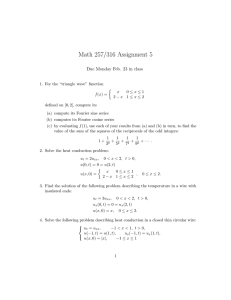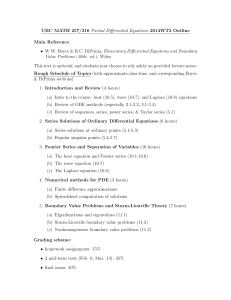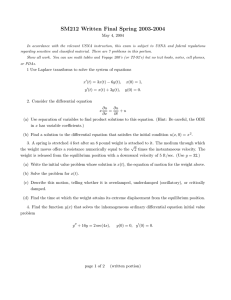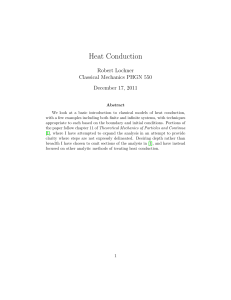10.1
advertisement
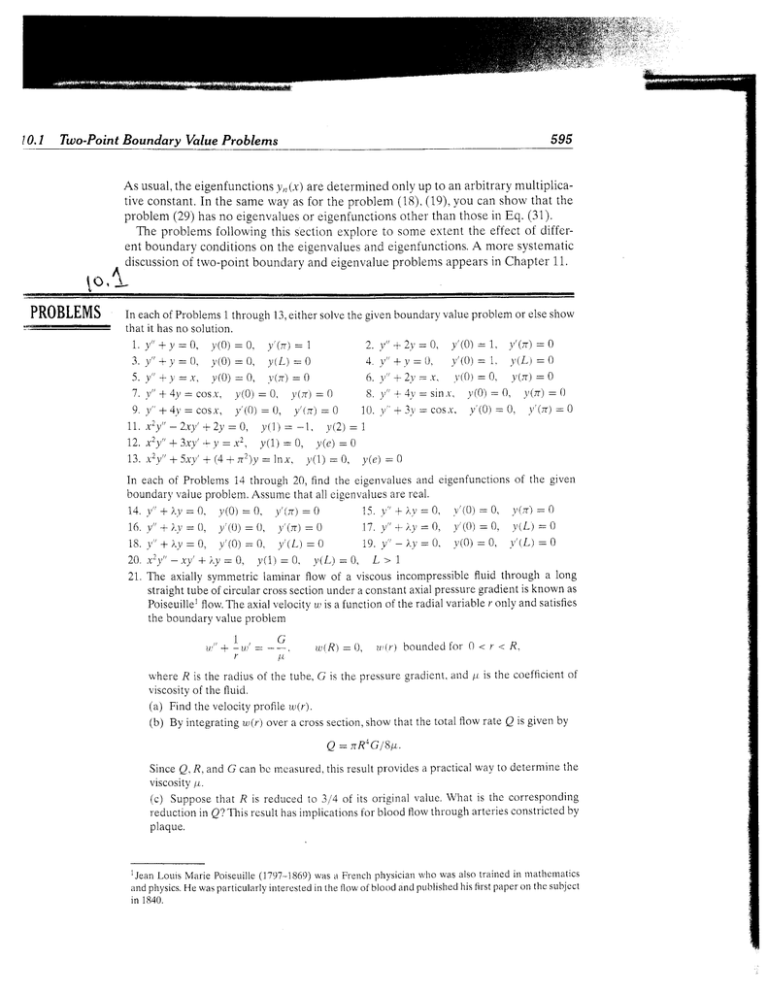
10.1
Two-Point Boundary Value Problerns
595
As usual, the eigenfunctions y,, (x) are detel'mined only up to an arbitrary multiplicative constant. In the same way as for the problem (18), (19), you can shorv that the
problen-r (29) has no eigenvalues or eigenfunctions other than those in Eq. (31),
The problems following this sectic'rr-r explore to some extent the effect of different boundary conditions on the eigenvalues and eigenfunctions. A more systematic
- discr-rssion of trvo-point boundary and eigenvalue problems appeals in Chapter 11.
[o,!
PR0BLEMS
In each of Problems
Lrra( rt tld)
1.
llu
1
through
13,
either solve the given bounclary value problem or else show
5(rluLl(rtl.
)"'+y = 0, )(0) = 0, l'(tt) =1
2.
1/'
1)y'=0,
l'(0)
: t, t'(r) :0
3. y" +y:1), t,(0) :0, y(L) = 0
4. l" +.y: (1. I'(0) = 1. t(tl :0
5. y" 11=-r. .v(0) :61, .t'(z) :0
6. 1"'12t - r. l(0) :0. )(z):0
7. )t'+ 4y: cos..-. y(0):0. ),(;r):0
8 J," +4.v: sin.r, ),(0):0, 1'(z):0
9 y" + 4,r'= cosr, y (0) : {), y'{it'1 :0
10. .y" f .jl : cos'Y, f'(0) :0. l'(;r) :0
I1.. x2y" - 2.r1" * 2l':0. ),(1): -1 , ),(2):1
12. x2y" -F 3xy''r- l: x2, ),(1) = 0, )(c) : L)
13. r2y" * 5;ry' * (4 + r'2)y : lnr, 1,(1) : 0, y(e) :0
In each of Problems 1,1 thr-ough 20, find the eigenvalues and eigenfunctions of the
given
boundarl,vaiue problem. Assume that all cigenvalues are real.
0, l,(r) :
15. r" f i.Y : O, r'(0) = 0, .Y(7) : 0
: (1, }'(z) : t)
17. y" *;.),= 0, 1"(0):0, )(L) = 0
y'(0) : 0. _y'(L) : 0
19. .y-" - il = 0. ,v(0):0, 1'(l-) :0
iy : O, l(1) : 0. y(L) : 0, L >
: 0.
= 0,
18. .y" + ),-v : 0,
_r,,,
+
)..y
16. y"
*
)"_t,
14.
20. xzS/'-.t)'+
1,(0)
=
Q
y'({))
1
21. The axially syrnmetric lan.rinar flow of a viscous incompressible fluid through a long
straight tube of circular cross section under a constant axial pressule gradient is known as
Poiseuillel florv. The axial velocitv u is a function of the radial variable r only and satisiies
the boundary value problem
.:
,1
+ -ur'- *:.
?./.'
r.vhere
R i, th. ,ultiu, o,
,,;-^^-:*,,
\ lJtuJrty
,Jl
ri-,(R):l),
rr'(r) boundedfor 0 < r <
R.
,u0", G is the pressure gradient. and /r is the coefficient of
fi.,1-l
^f +L^
ut
ttlc llulu,
(a) Find the velocity plofile u(r).
(b) BV integrating u(r) over a cross section,
shorv that the total flow rate Q is given by
Q = nRlGl\p.
Since Q, R, and G can bc rncasured, this result provicles a practical way to determine the
vlscoslty i/.
(c) Suppose that R is recluced to 3/4 of its original value. What is the corresponding
reduction in Q? This result has intplications for blood florv through arteries constricted by
plaque.
lJean Louis Marie Poiseuille (1797-i869) rvas a French physician lvho rvas also trained in rllathcmatics
and physics. t{e was particularly interested in the flow of blood trnd published his first paper on the subjcct
in 1840.
!
0.2
PRQBLEMS
'.:#
605
Fourier Series
In each of Problems
1
through
8.
determine rvhether the grven function is periodic. If so, find
its iundanrentiil peliod.
5r'
l.
sin
I
11..;={(.''
1'-',
ln<x<ln+1,
ll.
t
2.
3.
cos 2zx
t'^":'
R rtir
: { l. t
)i,',
(
-1. sin.'r.r/L
sinh 2"t
5.
tan
ir.i:
6.
x2
rr:0..-t .t2.,.
=t,=.'r,:l'l',
n
:
0, :11,
t2,
: -rfor -L < x < l.ancliff (.r * 2L): f (x),tttrdaformulafor.f (x)intl.reir.rterval
L < x < 2l;in the intet'val -3L < x < -2L.
[r+ l. -1<'r<0'
and if f('r +2)=f(x)'find aformulaforf('i) in the
lo lf/rtt:lr.
u<r<i.
t"
interval 1 <.r < 2; in the intervai 8 < r < 9.
11. Ifl(.r)=L*xfor0<,r<2L,andiff(.r-r2L):f(-i),findaformulafor'.f('t)inthe
inten'al -L < -r < 0,
f.
if l(,i)
12. Verifv Eqs. (6) and (7) in this section by direct integration.
In each of Problems i3 through
18:
(a) Sketch the grzrph of the given tur.rction for three
(b) Find the Fourier series for the given function.
13.
/(.t) : -r,
-L
<x<
.f(x-l2L) :
L',
Ir. -;=l:l
-L
ro':
1i,
'o
periods.
t(.x)
rG+21't=r(x)
(
lr'
--<.f
"^ <0.
15.fr.Yr={^'
"
[U. U<x<r:
,6 r(i
lr.\r-nJ =fr.r)
:{l:l -ilil?,
f(r+2):/(Y)
t
17.
f1r,: l:*t
-:='=1'
0 < t < L:
[L.
l().
t* -2<r'--1.
18. /(.t) :
I,t, -1 < -t < 1,
[0, 1<,r<2r
f(x+2L1=fqx1
f ('r + 4)
:
/(-t)
In each of Problerns 19 through 24:
(a) Sketch the grzrph of the givcn function for three perlods'
(b) Find the Fourier series for the given functiort.
(c) Plot the partial sum s,,,(r) vel'sus.r for nz = 5. 10. and 20'
(d) Describe horv the Fourier series seetns to be converging'
82 ts r,.
: l-l
t
''
SLzo l(..-t:.r, -1
-iii.l,
<.r<1;
/('r+4):/(x)
l(-r+2)=/(r)
Chapter 10. Partial Differential Equations
612
an{!9try
peroo:::through 6, assume that the give' function ls
ourside thc original intcrval
(a) Find the Fourier series for the extended function'
for three rt-,
of the functior.r to which the series converges
rn each of problerns
iu) ,*.r.n
I
.-'
the graph
--1<x<0.
l. / ('r) : J-i,
o<-v<1
t,
I
+.r, -L < "r < o,
3. .f (.r) = lr
la-t, o<.r<L
2.f*t=
/ i.r1 =
0, -r < .L < -n12,
ft. -:tlz1t<n12.
[o rl2<t<n
In each of pr.oblerns 7 through
o,
*tr < x <0.
[.t, 0<.r<;r
f
4./t.rl=1_ x2, -1 <.r<-
|
5.
'
6
12, assume
^ 1,,. -1 1r .0.
/tr)=1,.,'
0..r.<l
t"'
that the grven function is periodr:-
outside the origintrl interval
iat Finil the Fourier series for the given iunclton -bound or the maxlmum vai'-'
(b) Let en(x):/(x) - 't,,('Y)' Find the least upper
of
le,,
(x) I
:
fot n
10, 20, and 40'
(c) If possible, find the
6a I
64.
8'
6e
6e
10.
6Q. l1
6a
rr.r =
{i'
smallest n for which le"('t)l < 0.01 for all x.
-;:;:},
f(x+2t)
: f(x)
(seeSection
l02'Pro'c'-
l0'2 Pr': ' I.r+1, -1 <'v< 0'
f ('t + 2) = /t-t) (see Section
i;
o<-i'
10 2' Problen f (x +2'7 : f(xt (see Section
/(.r) = .r, -1 < .r < 1;
Pri : '
.
[x+2. -2<r < 0'
f 1.t * 4,1 = /r'r t {scc Section 10 2'
''-ll-^
J"'-
''-tt,.
12, f
ll-7r
t'
lo.
txl =.r
0<.r <2"
-1 <.r<0,
f (r +2'1 =
U:r<l:
-.f'r. -l
< .r <
J'(x)
(see Problem 6)
l('r + 2) : /(-r)
1l
PeriodicForcingTerms.Intlrischapter.wealeconcernednrainlvrviththeuseoiF-_.
tosolveboundaryvalueproblemsforcertainpartialdifferentialequations'Ho\\...
where periodic phenomena. occur. F: '
series are also useful i. ,iuny other situations
value problems $ . - :
;;;;J 16 indi.or" how the1, can be empioyed to solve initial
forcing terms.
problem
13. Find the solution of the initial value
- sinnl, )(O) :0' Y'(0) :0'
and a2 I il2 What happens tf "''2 = n2}
y" + azy
n'hete tl is a posttrve integer
value ploblent
14. Find the formal solution of the initial
l"
+t021,
= Ib,'sinirt,
,,- l
y(0) =
0,
.y'(0)
=
0
620
PROBLEMS
__9!!pp!J0.-Pqrtial
Differentiol Equations and Foax
jfi
Ineachof Problemslthlough6.determinervhetherthegivenfunctioniseven..,_-
r, .t- -
Lx
2, x3
3. tan 2.r
4,
-2x+7
sec.r
6.e'
In each of Problems 7 through 12, a function l is given on an interval of lengrh
sketch the eraphs of the even and ocld extensictns ol l ol period 21,
' r,,,, :{i,
9. l(.i-)
:=]
:2-.r.
[u
[t - l.
1{J. /1r1 :-r-3.
I. i.
0<.r<-l
,rr.
0<.r<
8./Lf):{"'
0< .r<2
12.
|'t.r):q
(r <
.\
-
13. Prove that ant' function can be expressed as the sum of two other functio'. . ,,
is even and the other odd, That is, for any function whose domain
f,
contarns , 1
lt contains .r, shorv that there are an even function g and an odd functro:, .;r
/(.t)=g(-r)+lz(.r).
Hittt;What can you say aboutl(.r)
+ l(-_r),1
14. Find the coefficients in the cosine and sine series described in Example
2.
In each of Problems 15 through 22:
(a) Find the lequired Fourier series for the given lunction.
(b) Sketch rhe graph trl tlrc iunction tu q.hjch the ser.ics con\cl.gcq
\rvcr thr.cc [-j:..._
o< r<
1< r...,
It.
7 ti I :
't'
1.
lo,
< .r <
Compare rvith Example
16 .l(r)
: r.
1.
:
18. Ir.r) :
17. l(.rr
1.
fo.
19. f(.r) =
t,
l;,
l.
cosine series' period 4
z,;
I
and problem 5 of Section 10,3.
0<.r < 1,
1 <.r- < 2:
(l<.r<lr;
l)
<.f
slne serles, Period
4
cosrne series, period 2;z
< n;
sine series, period 2:z
0<.r<2.
r<x<2t,
2r <x <3tr;
sine series, period 6z
x, 0 < .r < 1; series of perioil 1
27. ./(.r) = L -.r,
0 < .r < L:
cosine series, period 2l
20.
f (x) =
Compare rvith Example
22.
f(.v:L-r.
1
of Section 10.2.
0 < ,r <
In each of Problems 23 through
/,;
sinc series, period 21,
26:
(a) Find the required Fourier.series for the given runctlon.
(b) Sketch the graph oi the function to which the series converges lor three perrod>
(c) Plot one or lnore partial sums of the series.
ond Fowg
Chapter 10. Pattial Differential Equqtions
630
20
15
10
5
versus.r and t lor
FIGURB 10.5.5 Plot of temperature 'r
I
Example
ol
problem
the heat conduction
u.
5
PROBLEMS
lneachofProblemslthr.ough6,deternlinewlretherthemethodofSeparatlLrr.].'
of ordinar'
gif",r partial diffelential equation by a pair
can be used to replace tn.
equrtions ll
-5
1. .rtt,,
3. u,,
5.
*
*
so.
ttr
tt,1
-:-;
find thc equations'
=
0
*
ll1
2' ttt" * -l-ll1 = 0
4' [P(:r)u'l' - r(x)ftl' = 0
: 0
6' tl"*ll-r'r'+'rll=0
r..*(x*y)tt,'r,=u
problem
7. Find the solution of the heat concluction
100u,,:rrr,
ri(0, l) : 0,
rr(.r,0)
0<x<1. I>0;
L(1, r) : 0, I > 0;
= sin2r.r -sin5rx,
0
<'r < l'
problem
8. Find the solutlon of the heat conduction
11,,:4tt1, 0<r<2, l>0;
I > 0:
u(2't) :0'
r/(0,/) = 0'
rr('r,0) = ?s\n@xlL) - sinz'r'+ 4sir.r2z'r'
0 <.r; < 2
Considel.theconductronofl-reatirrar.od40crrrinlengthrvhoseendsaremalni::
i2'find an expression forlhe tempe:'
for ail r > 0. ln.utfl oiptUfems 9 tlirough
is the giver.r function Suppose th'
rocl
tie
in
if the initial ,rnlp.ru,u," oisfiibution
9. u(.t,0) : 50. 0 <'r; < 40
10. u(.t, o)
=
lr,
i+o
_
.r,
0 <.t < 20,
/Q<r<41)
,k
Qt'
.:.
Chapter 10. Portial Differential Equations and Forr.rc
632
recluces to
u
dE2
02
0.q-.1. r>i)
dt.r
0r
2t, Consrde r the equation
aur,
*
IsLr,+ cil
=
u,
rvhere a, b, ar-rd c are constitnts.
(a) Let tr(r,t1:edtut(r,t), rvhere 6 is constant, and find the corre:i'
differential equation for u.
(b) If l, 10, shorv that d can be chosen so tl.rat the partial differential e;*.
part (a) has no term in ru. Thus, by a change of depenclent variable, it is pr','
Eq. (i) to the heat conduction equation.
22
The heat conduction equation in two space dimeustons
cr2(lt',
Assunrins that ri(.r,.t', t)
satisfied b)" Xi.r), y()
LJ
ts
- t.trt'): trr.
: X(.r)Yt11'l(1,lind
orclinar-y differential equ.
), and Z(r).
The heat conduction eqr,ration in two space dirnensions n-ray be expressed i:coordrnates as
a)ltt,, + olr)u, * (\lr2)tL6"l: v,.
Assuming that rr(r.6,r): R(r')O(d)
satisfied by R(r), O(6), ancl T(t).
I(t), find ordinarv diffelential
equa:
10.6 0ther Heat Conduction Problems
In Section 10.5 rve considered the problem consisting of the heat conducl:
a2urr:Y1,,
0 <-r <
L, I>0,
the boundary conditions
,r(0,1)
: 0,
Lt(L,t)
:0,
I>
0.
and the initial condition
a(n,0):l(.r),
0<.r<L.
We found the solution to be
r/(r.
'ttv 1)
't
:-
n)n) )' t2
\-,..
l,r',,
lllf'Y
sln
rvhere the coefflcients c/r are the same as in the seties
r,r, :
/f,"r-\-..
i;
irr
tlrI\
LLilSln --tI'
,-r
.
L
.
